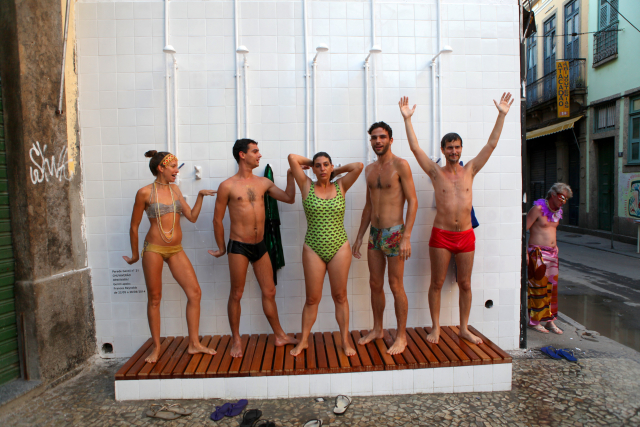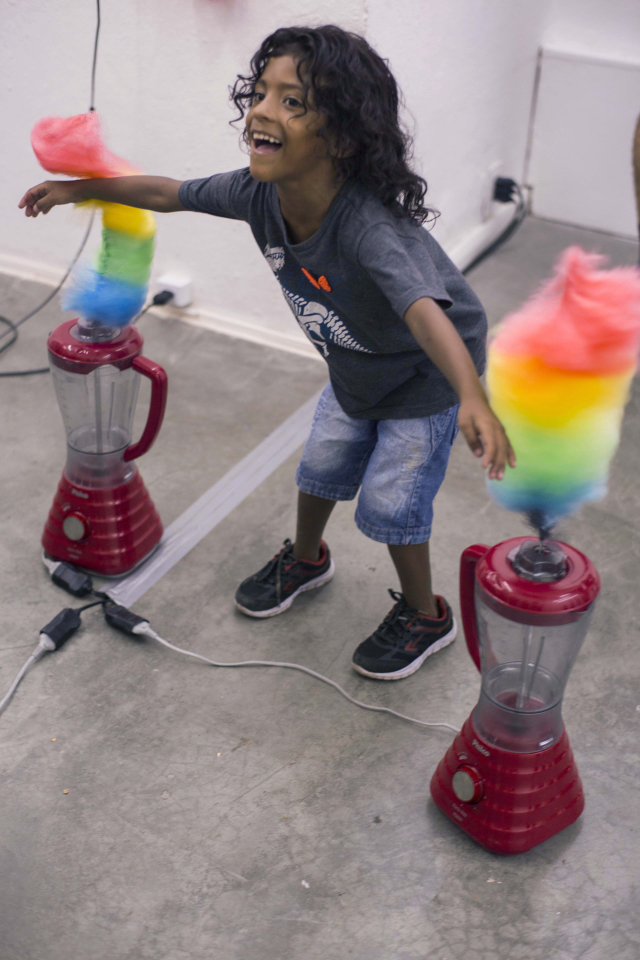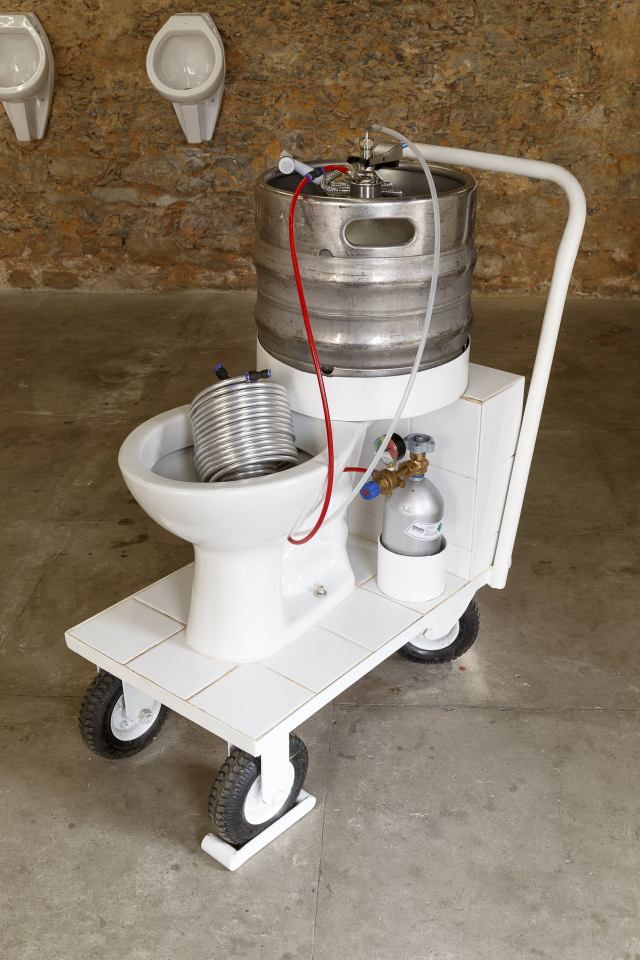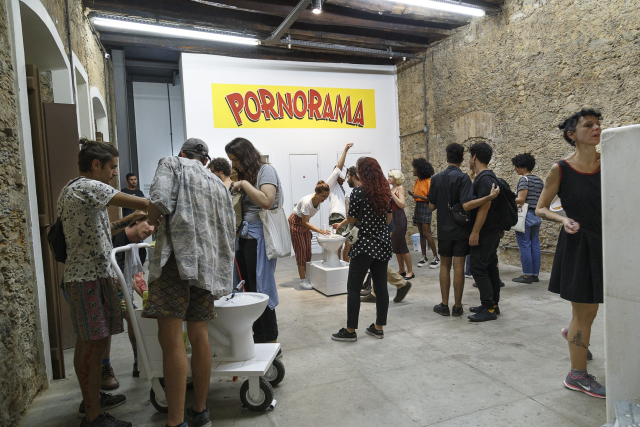Opavivará: Pro Concordia Labor
Opavivará turns the experience of art into the work of art, for questioning our needs as human beings. Even if these needs are rarely what they seem.
Opavivará, that is the art collective created in 2005 by Callado Julio, Dawson Ynaiê Cintra, Guimaraens Domingos and Toledo Danie, is going through a very busy period. These days they are taking part to the Zone Artistique Temporaire in Montpelier with Abre Caminho – a public shower that turns into a metaphor the intimate act of washing oneself. This year, Nicolas Bourriaud, theorist of relational aesthetic and curator of the fundamental Tate Triennial in 2009 (the one dedicated to the concept of ‘Altermodern’) has invited to Montpelier 100 artists who are going to produce as many ‘public’ works. The municipality becomes thus an artistic platform, that will bring art to their citizens (rather than its citizens to art, as instead it would have happened if the artworks had been exhibited in a museum). The 2019 edition of ZAC lasts until July 29th. The exhibition by Opavivará at A Gentil Carioca, the only gallery that today represents the collective, ended last week in Rio de Janeiro. Title: Pornorama. Also in this case the artworks are metaphors, albeit of innocent pleasure; after all, what would you expect to get from caressing a feather duster assembled on a blender? Giggles. The title is nothing more than a kind coincidence. It isn’t about vulgarity nor indulging in the dark side, that is where men are more or less powerless victims of their own desires (here is a reference to our writing on Zoe Williams’ art practice). Rather, it is about irony (making fun of Bolsonaro’s preachy regime), spontaneity, joie de vivre, willingness to neutralise the opaque power of guilt.

Opavivará, Chuvaverão, 2014, Parede Gentil. Courtesy of A Gentil Carioca.

Opavivará, Pornorama, exhibition views. Courtesy of A Gentil Carioca.
Opavivará, a ‘Rede Social’.
Between Rio and Montpelier, there is the city of Florence, that has asked Opavivará to install a giant and colourful hammock in the courtyard of Palazzo Strozzi – which is currently hosting the first retrospective dedicated to Andrea Verrocchio (here the link to our writing about the master of Perugino and Leonardo da Vinci). The hammock is obviously for public use, and the many visitors that come to the capital of Renaissance, especially during Summertime, are invited to enjoy this installation. The work of art is titled ‘Rede Social’, that is social network. It is indeed another metaphor, easy to understand and funny to use. We tested it the day before its opening to the public. The game of passing from a colour to the other makes you feel like a child who tries to move, as he can, by using all of his body which on the hammock can’t really count much on the sense of balance. Just like the shower in Montpelier has been preceded by an earlier one, Chubaberao, created in 2015 by Opavivará for edition n° 21 of Parede Gentil (here is the link to the project which, thanks to the support of collectors, encourages artists to intervene on the side façade of A Gentil Carioca). Rede Social has actually come to life some time ago. Precisely in 2017, at the Espaço Cultural Porto Seguro in Sao Paulo: ‘This work creates a space where you can relax with no hurry, a place of experimentation and interaction’ as described on Opavivará’s website (which we highly recommend to navigate, here is the link). The year after another version of Rede Social was presented at the Womad Festival in Malmesbury, UK and was also part of Utopya, the exhibition Tate Liverpool dedicated to the collective.

Opavivará, Rede Social, 2019, sewed hammocks installation view at Palazzo Strozzi.
A gentle golden shower.
This year, before Rio, Montpelier and Florence, there has also been Dubai, and its art fair, where Opavivará politely challenged the local customs by building a huge dome made with the same sun umbrellas under which people lie – more or less undressed according to their culture and gender – by the pools of luxury hotels. Umbrellas could have been white. However, in order to avoid any doubt that in this instance it could have been purely a formal act, perhaps in honour of the Moorish architecture and its wonderful writing style, here comes that also the umbrellas are of the colours of the flag designed by Cora Slocomb at the end of the 19th century with the Pro concordia labor motto on it. When formal elegance also matches stylistic elegance then the message hits the target. It is not a matter of provoking, but rather of making you think by playing the card of lightness. As in the case of the ‘Golden shower’ exhibited at Pornorama, that is beer poured from the hygienic shower of a toilet, or ‘Aguardente’, cachaça (to drink) gushing from an extremely clean ceramic bidet. Hence, we are very far from that imaginary and bleeding line that starts from the Viennese Actionism to reach the Gelitin by going through the many sexual (and creative) morasses that were created in the turbulent Nineties, while the phenomenon that at the end of the decade took the name of globalisation was actually happening.

Opavivará, Golden Shower, 2019, barrel of beer, CO2 cylinder, serpentine, toilet, hygienic shower, hoses and connectors. Courtesy of A Gentil Carioca.

Opavivará, Pornorama, exhibition views. Courtesy of A Gentil Carioca.
A part, the whole.
It is not by coincidence that Nicolas Bourriaud developed his Relational Aestethic during that time (the book that talks about it was published in 1998). Opavivará makes an updated and positive interpretation of it, that is ‘an art taking as its theoretical horizon the realm of human interactions and its social context, rather than the assertion of an independent and private symbolic space’. So the trajectory of the metaphors is defined and the idea of enjoying art in a group makes sense – this has been up to now a constant in Opavivará’s art practice. In his pivotal book Bourriaud also talks about a society unable to directly live the experience of interpersonal relationship, which blurs into a ‘spectacular representation’ of itself. The social network regime would have made its appearance only a few years later to ‘reify’, that is turning the space where social interactions take place into a object (marketable). In Opavivará’s art practice all these problems seem to find an answer, and this is possibly the strongest distinctive element that diversifies it from those who chose to work, alone or in group, in the ‘social field’. Through pleasure, that is an anthropologically positive signal that the body sends to our brain, Opavivarà celebrates (or rediscover) the value of the ‘analogical’, epidermic, human social interaction, thus asking the exhibition space to regain its role as an institution which deals with political and social issues, rather than having merely economic, or even worse, commercial aims.

Opavivará, Solaroca, 2019, mixed media dimensions variable, as presented at Dubai Art Fair. Courtesy of A Gentil Carioca.
November 25, 2020
